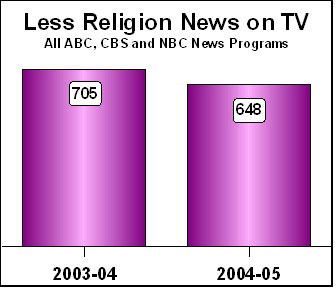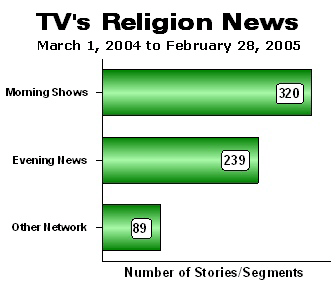Religion on TV News:
Table of Contents:
Introduction
As America approached Easter last year, it seemed the 25th anniversary of John Paul II’s pontificate and the religious and commercial phenomenon surrounding the movie The Passion of the Christ had ushered in a new height for religious discussion in the news media, but it would have been easy to predict that this focus would not last. The Pope’s failing health means less headline-grabbing action, less globe-trotting evangelism, and more symbolic suffering with the burdens of age and the ravages of disease. Pre-release publicity about The Passion’s potential effect for violence and hatred was hotter and heavier than post-release coverage of the movie’s peaceful and profitable reception.
Did the network news divisions predictably lose their interest in religious news topics? To measure the trend, MRC analysts surveyed every religion news story on ABC, CBS, and NBC news programs in the 12 months from March 1, 2004 through February 28, 2005. We then compared those numbers to the numerical highs of last year’s study of the matching months.
 Religion coverage is down, but not as much as
might have been expected. Overall, there were 648 total religion news
stories in the 2004-05 study period, down from 705 religion news
stories on the Big Three last year. The real slippage came in evening
news coverage, which fell from 292 a year ago to 239 this year. By
contrast, the number of morning show segments was nearly the same (331
in 2003-04, down to 320 in 2004-05) and the number of magazine and
interview show segments went up slightly (from 82 to 89).
Religion coverage is down, but not as much as
might have been expected. Overall, there were 648 total religion news
stories in the 2004-05 study period, down from 705 religion news
stories on the Big Three last year. The real slippage came in evening
news coverage, which fell from 292 a year ago to 239 this year. By
contrast, the number of morning show segments was nearly the same (331
in 2003-04, down to 320 in 2004-05) and the number of magazine and
interview show segments went up slightly (from 82 to 89).
One major reason for the smaller-than-expected decline was Pope John Paul’s two hospital trips in February. Without the surge in Vatican stories in February, the previous 11 months contained only 175 evening news stories, which would have been close to only half of last year’s total. The morning show total would have declined by 63 stories to 257. The magazine and interview shows were almost unaffected.
The other finding of last year remains: Network coverage continues to explore religious issues through secular and political lenses, skeptical of religion’s claims on the American imagination. Journalists were taken aback after the 2004 elections at what pollsters discovered about the electorate. Newsweek found 82 percent of Americans believe that Jesus Christ is the Son of God, and 67 percent agreed that the Christmas story, “the Virgin birth, the angelic proclamation to the shepherds, the Star of Bethlehem, and the Wise Men from the East is historically accurate,” instead of “a theological story written to affirm faith in Jesus Christ.” A Gallup poll found that 82 percent of Americans believe the Bible is either the literal Word of God, or the inspired Word of God, compared to just 15 percent who said the book was comprised of “fables.”
 Depending on the poll, anywhere from 72 percent to
77 percent of Americans support posting the Ten Commandments on
government property, even if they’re more skeptical about politicians
taking too many cues from religious leaders, or having preachers
endorse candidates from the pulpit.
Depending on the poll, anywhere from 72 percent to
77 percent of Americans support posting the Ten Commandments on
government property, even if they’re more skeptical about politicians
taking too many cues from religious leaders, or having preachers
endorse candidates from the pulpit.
Journalists, by contrast, are historically a class that has feared that religion is exclusionary, intolerant, and latently theocratic. ABC morning host Diane Sawyer spoke for that viewpoint in relaying the concerns of “Kerry voters” on November 4 to Bush adviser Rev. Joe Watkins: “There’s a definite sense this morning on the part of the Kerry voters that perhaps this is code, ‘moral values,’ is code for something else. It’s code for taking a different position about gays in America, an exclusionary position, a code about abortion, code about imposing Christianity over other faiths.”
On the November 7 Meet the Press, host Tim Russert announced: “One Democrat said to me, ‘Are we on the verge of a theocracy, where if you don't agree with the president and evangelical Christians on abortion or on gays, there really is no room for you to practice what you believe in the United States?’”
What bill would be introduced in Congress to “impose” Christianity? What “theocracy” is emerging? They did not explain.
That disconnect on religious faith between the media elite and the public comes through on network television, no matter how routinely the religion stories are reported. Their coverage suggests that religious Americans should meet the demands of a secular orthodoxy, never daring to bring religious beliefs into the political agenda or let religious ideas influence public opinion on social issues. Even when the amount of religion news increases, the media’s tone remains wary of ancient dogmas, preferring modernist interpretations that require few changes in attitude and behavior that would set a believer apart from the popular culture, or at odds with the secular media worldview.


